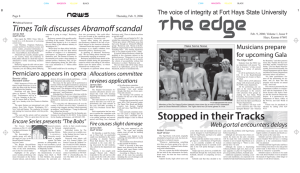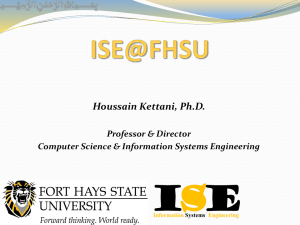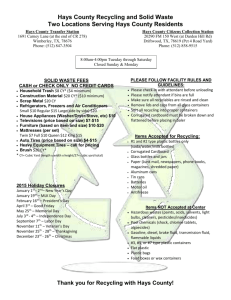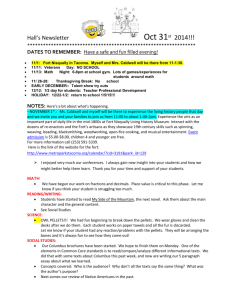Business Development Opportunities through “Behind the Meter
advertisement
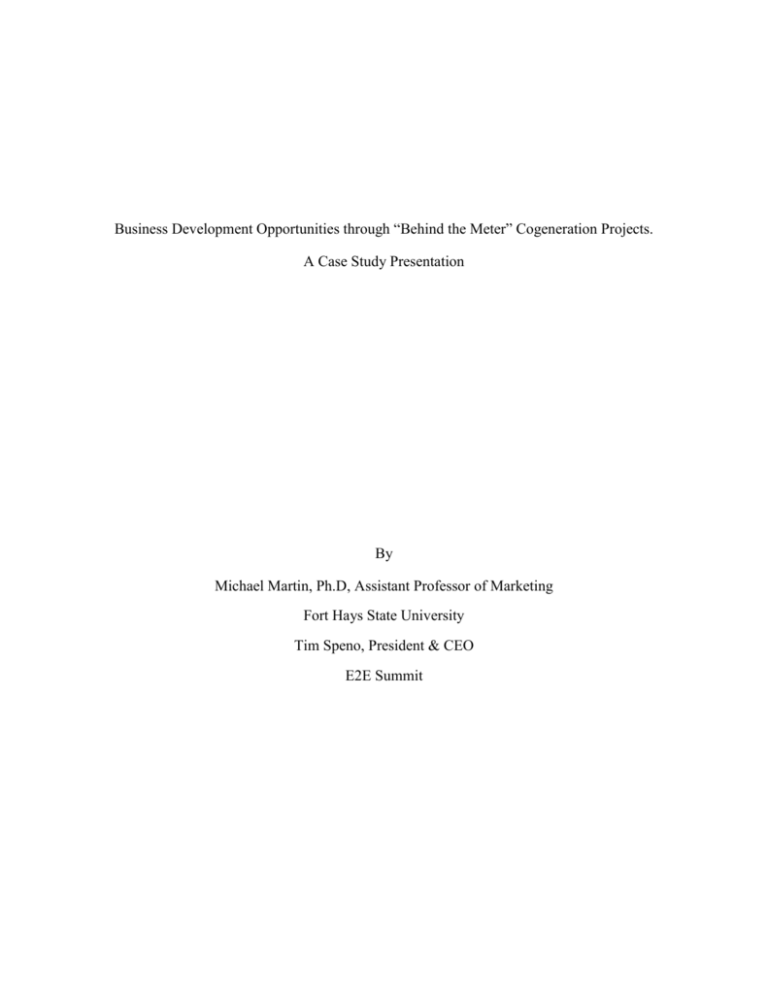
Business Development Opportunities through “Behind the Meter” Cogeneration Projects. A Case Study Presentation By Michael Martin, Ph.D, Assistant Professor of Marketing Fort Hays State University Tim Speno, President & CEO E2E Summit Fort Hays State University Fort Hays State University, located nearly halfway between Kansas City & Denver in Northwest Kansas, is a model of innovation and fiscal responsibility as an institution of higher learning. Fort Hays State was the first campus in the state of Kansas to have fully mediated classrooms where professors and students could engage with technology throughout the learning process. For over twenty years, the university has improved access to higher education through its distance learning initiatives, becoming an example for other institutions attempting to grow enrollments in shrinking market areas in the face of declining resources for education. As a leader in online education, Fort Hays State has truly gone global, becoming the first American university to be granted approval by the Ministry of Education to offer a bachelor’s degree in mainland China. While high schools in Western Kansas have consolidated and small towns have continued to decrease in population, Fort Hays State University continues to update facilities and construct new buildings, including the FHSU Indoor Athletic Training Facility, and the Center for Networked Learning, expected to be completed in fall of 2014. So with the challenge of a shrinking market area and reduced funding for higher education, the University has been successful in reducing costs and also raising capital in order to complete projects that will benefit FHSU and its stakeholders into the future. This model of fiscal responsibility, especially in the area of energy management, makes the university a likely place to be able to complete a project for wind energy and do it in a way that makes good business sense. Like other institutions of its size, Fort Hays State has seen increased demand for electricity. With the installation of computer servers, a campus-wide wireless network, and remodeling of the Memorial Union and other campus buildings comes an increase in the use of electronics which lead to those increases in demand for power. While new construction may be more energy efficient, turning unused space into used space and increasing traffic flows through buildings will help increase the aforementioned demand. FHSU began looking at energy management systems (EMS) in the mid-1990s with two buildings on campus, Tomanek Hall and Sheridan Hall. The university was interested in reducing costs associated with energy prior to that, but EMS became more viable on a larger scale during that period. As time progressed, the institution began to increase its energy management program to include building diesel generators to utilize during peak usage times; peak demand shaving. The construction of these new generators that helped to manage that peak demand saved the university nearly $200,000 per year when combined with other energy management initiatives. The ability to realize these savings gave Fort Hays State the capability to create a source of funding for the wind energy project. In addition, FHSU has been a leader in terms of managing supplier relationships and cost control across academic and non-academic departments. The Business Case for the FHSU Wind Project As evidenced by its “Affordable Success” strategy in the early 2000’s, the university has sought to provide the highest quality education while keeping tuition costs down. Keeping tuition increases below 10% per year while other Kansas Board of Regents institutions raised tuition as much as 25% helped to cement FHSU’s reputation as an institution that provides tremendous value to its students. During the years 2002 – 2007, Fort Hays State as the only state university in Kansas to see a decrease in operating costs per student credit hour. The university has saved over $1.5 million by consolidating some of its education departments, as well as completing construction projects and software development in-house instead of hiring outside employees. FHSU has also controlled costs by also developing online courses in-house. Ultimately, the business case for the project was built on FHSU being a consumer of energy, not a producer. Like other places, energy costs at Fort Hays State have continued to rise. Some of this cost at FHSU can be attributed to an aging and dated electrical system, which has high upkeep and maintenance costs. Fort Hays State has taken the lead in energy management, beginning with energy management systems built in 1996. The University was spending roughly $2.4 million per year prior to starting their own energy management initiatives and then beginning a relationship with Chevron in 2004 to manage energy usage in additional buildings on campus. By initiating this type of monitoring and control, the institution was able to save around $350,000 per year on average. Moving into the construction of diesel generators to handle peak demand and beginning peak demand shaving using additional diesel generators in 2004, the university continued to reduce energy costs. Through construction of the wind turbines, the institution expects that the energy generated will meet over 95% of the energy used by the campus, and the current projected savings from using wind energy is $700,000 to $1.6 million annually. The justification for building wind turbines and generating electricity is founded in the meticulous nature of the FHSU business model. Operating efficiencies are gained from experienced leadership making timely, well-planned decisions and a focus on meeting institutional goals while carefully allocating resources. As the examples listed above suggest, fiscal responsibility at the institutional level leads to a low debt ratio and the ability to think in terms of self-sufficiency with respect to project investment. Another game-changing element of the FHSU scenario is that the university did not have to rely on government assistance (and the often cumbersome requirements it presents) in order to achieve its goal of energy independence. Wind Energy at Fort Hays State University The Kansas Board of Regents (KBOR) adopted a policy on sustainability in 2008 and required its institutions of higher education to respond with a sustainability report. FHSU is proactively involved in environmental issues, as well as educating students on the value of service to the community, and the requirements for being a responsible civic member in the fastpaced, global environment. The university also recycles waste oil, fire extinguisher powder, refrigerants, batteries, toner, and a number of other materials including paper, of which 8.5 tons per month have been sent to the city recycling center. From a strategic perspective, FHSU includes sustainability as part of its planning process, as all renovation and new construction projects are designed to provide the most efficient energy use as possible amid scarce resources. With respect to utilities at FHSU, modern steam separators were installed to run steam boilers more efficiently. These boilers have been maintained so that they will burn fuel sources more effectively, using less natural gas and fuel oil, which reduces emissions. In FY2010, the university saw decreases in electricity usage for three of the larger buildings on campus due to efficiencies gained from summer program reductions, accurate facility scheduling, and set back strategies that reduce usage during periods of low building activity. Additional savings were realized with adjustments to lighting with the use of special reflective lenses and a conversion to energy efficient T-8 lighting technologies, as well as occupancy sensor lighting controls. Greening measures at FHSU with respect to utilities include replacing older air chillers, condensers, and rooftop units, optimizing operation of boilers, expanding the energy management system, and conversion of HVAC equipment to variable speed technologies. Additional measures include wall insulation of exterior masonry walls and window technologies that apply thermal, low E glazing to improve aesthetics as well as performance. The construction of the FHSU Wind Project became a reality due to a number of factors. The planning for the FHSU wind farm goes back several years to when FHSU was experiencing success (cost savings) in energy management and peak shaving activities. Necessary to the process are the opening wind assessment to determine the wind resource at the site, which turbine models might perform best at the site, and the basic financials of the project. The report generated with this information can serve as a go/no-go document to the institution. Another important development in the pursuit of an energy project such as this is the county/city zoning issues that arise. The FHSU project faced serious opposition upon the initial attempt at the project. There was a prohibitive wind ordinance within 3 miles of the city, so the project had to be developed outside of that (at 3.5 miles). The county commission had previously denied a larger wind farm with lasting repercussions. The county wind ordinance was written for this larger wind farm and the small project development plan written for the FHSU project had to be written to the same exacting standards. The plan was approved by the county zoning board and subsequently approved unanimously by the county commission. An election had taken place during the early stages of the project and the composition of the county commission changed, allowing the project to move forward. As indicated by information provided through interviews with several key players in the FHSU Wind Project, the management team was critical in making the project a reality. Dr. Edward Hammond’s years of experience in managing change and leading the university through twenty years of innovation was very instrumental in making wind energy a reality. In addition, the team that is assembled around Dr. Hammond has expertise in various areas that made the project go more smoothly. A thorough understanding of the legal issues of this type of project is necessary to its success. A land lease was negotiated with the landowner, and also three easements necessary for widening the roads for transport, and a Roads Agreement with the county. Mike Barnett, Vice-President for Administration and Finance knew that a wind project would not be pursued if there was no financial viability to it, and access to land for the turbines and trench to carry power to the campus was a tipping point in making the project a reality. The wind data that is critical to being able to green-light a project of this magnitude was already being gathered at FHSU. A larger Met tower, able to measure wind at three levels, was constructed as part of the FHSU wind project and Dr. John Heinrichs, Department Chair for Geosciences at FHSU requested meteorological equipment for enhancing the existing FHSU weather station. The ability to measure wind at three levels provides very valuable data to the project and helps to ensure that the measurements taken by the turbines are indeed credible. While the Met tower exceeds the height allowed within the 3 mile COH purview, the height limitation was overcome by the tower’s use a weather station. Dr. Heinrichs’ expertise in this area provides further credibility to the project and additional research/partnership opportunities going into the future. As mentioned earlier, FHSU has been proactive in reducing its utility costs using energy management systems as well as peak shaving activities. Keith Dreher, Manager of the FHSU Energy Division, has over 20 years of experience with power generation and utility construction and maintenance at the University. His knowledge of the systems and hands-on experience working with energy management and peak shaving are also significant in making a successful transition to cogeneration. Dana Cunningham, FHSU Architect, also has experience planning various building projects at Fort Hays State and has a strong understanding of the process and what to consider when bidding construction for various campus ventures. According to Wayne Hildreth, partner at WECC, projects of this nature have “many moving parts” and when facts and issues are presented with solutions, a project can be successful. The expertise of the FHSU team was enhanced by the capabilities of WECC, a wind energy consulting company based in Oklahoma. WECC provides turnkey solutions for wind energy projects by providing specialized resource analysis, wind measurement with data analysis and reporting, project design and planning, financial modeling, economic impact assessment and wind resource mapping. In addition, WECC also provides project development, project management and engineering services. When coupled with the team assembled by FHSU to make wind energy a reality, this specific project expertise was very valuable. WECC actually acted as a representative of the project owner (FHSU) and was the catalyst that helped the project go more smoothly. WECC created and presented the Development Plan for political approval, drafted the RFP for Balance of Plant and assisted with contractor selection, was instrumental in land acquisition, utility negotiations, and with negotiating the Turbine Supply and Operations and Maintenance Agreements. While other projects of this type might involve an engineering firm that contracts out the different activities to third party providers, increasing the total cost of the project. WECC was able to provide testing services and other project assistance, representing the FHSU owners, and reduce some of the typical costs associated with wind projects. Another way WECC provided expertise was in the vetting of study providers and wind turbine manufacturers. Using a study from a company that may not be absolutely bankable can be a critical mistake in that incorrect data will drive costs up and possibly end a project before it gets any traction. The use of a unique wind energy consultant like WECC also helps an owner get all parts of the project completed in a more favorable time frame without missing crucial elements of the process. The first study, the Preliminary Wind Resource Assessment helps to set the stage for the project and can also be go/no go indicator for the owner. Again, FHSU already had good data concerning the wind at the site it was considering for the turbines, so the project was ready to move forward. WECC provides oversight in getting the proper tests done, the zoning permissions completed, and the actual construction of the wind farm. They helped the FHSU owner at each step in the process and ultimately helped the owner reduce its costs. According to Dr. Edward Hammond, FHSU President, an energy project has three major components: politics, technology, and finances. The political realities of this type of project exist at the city, county, and state level, as well as a corporate level with the local utility company. The city and county had experienced some difficulty with a previous wind project and there were definitely wind energy opponents seated in local government. Eventually, the landscape changed and wind energy became more acceptable, garnering the support of the county commission. Constructing an energy project of this magnitude would have to involve workng with the Kansas Corporation Commission. The KCC has regulations in place that prohibit more than one utility from operating in a geographic area. Since Midwest Energy is the local utility, Fort Hays State had to find a way to be able to build the wind farm to produce energy and stay within the rules of the KCC by generating power from the wind without being considered a utility. Dr. Hammond’s experience in dealing with the political aspects of his job was instrumental in making the project happen and WECC also assisted in discussions concerning this political environment. Dealing with the local utility also presented challenges. The local utility has been a partner of FHSU for many years and the wind energy project affected their business. In this case the company was concerned about energy being created by FHSU back-flowing into its system and creating a safety issue for its linemen. The University and Midwest Energy are still working on completion of interconnection requirements of the new systems to ensure the necessary protections are in place, and have agreed to interim measures. Technology is another critical component of an energy project. Fort Hays State has leveraged technology its benefit for twenty years, both in the classroom and in its management of energy. By entering into agreement with Chevron, FHSU was able to use power much more efficiently and realize savings of $350,000. The institution continued to be a leader in energy management with the installation of gas generators for peak shaving, in which FHSU transferred generation during peak usage periods in order to reduce the amount of electricity taken from the utility. The peak shaving initiative greatly reduced FHSU’s energy costs once again and set them up for further efficiencies from using wind power. Now the University has developed a 2-turbine wind farm of 4MW in nameplate capacity to generate power with the goal of making FHSU less dependent on the local utility and subsequently realizing tremendous cost savings. This renewable energy project will also provide learning opportunities for FHSU students and help to create educational partnerships with community and technical colleges. The third major consideration in an energy project is the financing of the project. Fort Hays State has been able to finance wind energy without having to rely on government funding or private investment. The University was able to leverage significant cost savings from energy management and peak shaving to pay for the cogeneration project. FHSU was in a good financial position with respect to energy and was able to show its ability to control costs by proactively changing the way it uses energy over the past two decades. It was a natural step for FHSU to move even further toward energy independence by pursuing cogeneration. According to Dr. Hammond, even with the “do nothing” scenario, Fort Hays State would be spending $2.4 million for energy. The savings with the wind project could be as much as $1.4 million per year for 10 years after a total investment of $11.4 million, with the life of the project rounding out to around 25 years with proper maintenance of the equipment. Even with a lower estimate of $1 million in cost savings annually, the project still works. Again, the ability of FHSU to keep costs down through energy efficient operations helped to make this project a reality. Moving Forward with Wind Energy at FHSU With the pending completion of the FHSU Wind Energy Project comes additional opportunities for forward thinking energy solutions. One of the more prevalent arguments against wind energy is the challenge in storing the power. Fort Hays State is currently looking at storage solutions available through a large manufacturer and is considering which alternative will work best with its system. The University is also looking at a microgrid as the next step in selfsustaining energy as a means to efficiently manage disparate sources of energy, storage and campus building controls. The idea behind the microgrid is that it would allow a small project like the FHSU wind farm would be able to manage its power more efficiently and not have to rely on the larger local power grid. It is very important that the Energy Division team at FHSU work through the management of the wind energy and any challenges that it presents before undertaking the construction and management of a microgrid. The University is exploring the microgrid opportunity with a vendor as well, but a decision has not been made on when or how that part of the project might be completed. As mentioned previously, FHSU has opportunities to use the wind project as a catalyst for expanded learning opportunities. The farm serves as a model that could educate students from the high school level to the graduate level and attract students to Fort Hays State. One way this might be accomplished is by leveraging existing community college and technical college partnerships to provide an increased number of courses and programs at FHSU. There are already discussions with Cloud County Community College to use the Fort Hays State wind turbine generators as a live laboratory for their existing and impressive wind energy program. Dodge City Community College is another partner that would be able to benefit from additional course offerings. Now that FHSU has found a way to harvest wind power to produce its own electricity, the next step would be to look to the sun and invest in solar energy. While costs for solar power are high and there are still some challenges associated with its successful implementation in this setting, it’s definitely on FHSU’s radar for future projects. It’s expected that the University will continue to use energy efficiently and create an opportunity for the exploration of solar energy in the not too distant future. In any case, the institution continues to serve as an example in fiscal responsibility and energy efficiency to other colleges and universities in the state of Kansas and beyond.

